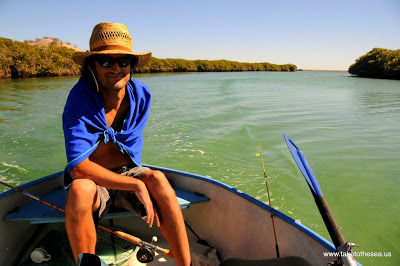 The return of dinghy man.
The return of dinghy man.
Log Book
- Departure time: 8:00 am on March 3, 2013
- Arrival time: 6:00 pm on March 3, 2013
- Total travel time: 10 hours (with a side trip to Bahia Amortajada)
- Nautical miles travelled: 12.6 nm
- Engine hours start – end – logged: 994 – 998.5 – 4.5
- Gallons of diesel start – end – used: 29.4 – 27.6 – 1.8
- Weather: The forecast predicted 10-15 knots of wind from the N/NW with a southwest swell of 2-4 feet.
It wasn’t a great day for sailing, per se, since the wind was so light, but we were pretty eager to move on to the next anchorage. We also wanted to check out the mangroves and lagoon at Bahia Amortajada, which was en route to San Evaristo. We motored to Bahia Amortajada past Isla Coyote, which is a very small inhabited island in the Sea (I think the only inhabited island). The beach at Isla Coyote appeared to be very active with sea kayaks and pangas.
 Isla Coyote.
Isla Coyote. 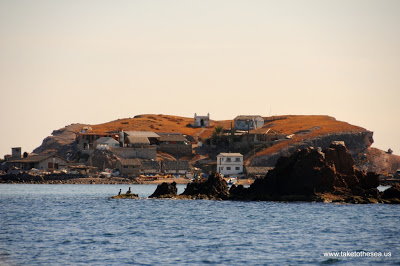 Isla Coyote
Isla Coyote
We dropped our anchor in about 25 feet of water at Bahia Amortajada after discovering that it shoals very very rapidly (like scary rapidly) – it went from 18 feet to 6 feet in a matter of seconds. We put the outboard on our port-a-bote Miss Nomer, made some lunch and packed Miss Nomer full of toys and goodies. We motored into the mangroves at 11:00am, the beginning of the flood tide, and once we were over the sand bar, we were able to drift with the current and soak up the sun (for the first 30 minutes…at which point we began trying to hide from the sun).
 The entrance to the mangroves.
The entrance to the mangroves. 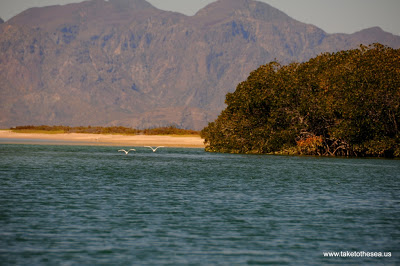 Little egrets (Egretta garzetta) or Snowy egrets (Egretta thula)?
Little egrets (Egretta garzetta) or Snowy egrets (Egretta thula)? 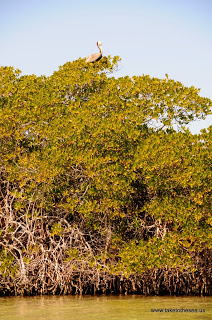 That is quite the perch.
That is quite the perch.
Jeff kept the two fishing poles dangled in the water during our float trip and I used the oars every now and again to keep us from scraping up against the foliage. The waterway was lined with what I believe to be Red Mangrove (Rhizophora mangle), though it could have been white mangrove.
The amount of fish that found refuge in the mangrove was incredible and helped to explain the proliferation of birds. When we pulled off into a side channel we were astounded at the number of large fish. We sat there with our tackle in the water, feet from their curious faces, but none of them took the bait. It was somewhat painful to sit there and see the fish actively rejecting your tackle. Fresh bait probably would have fared much better than rubber.
When we reached the lagoon at the end we hopped in for a swim and were shocked by how cold the water was. It was welcome, however, given the heat of the day.
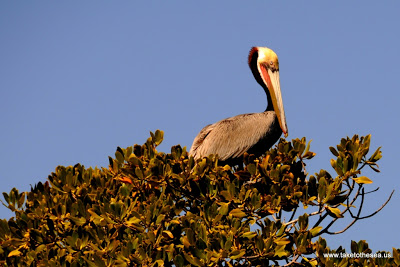 Brown Pelican (Pelecanus occidentalis) – such beautiful coloring! This pelican was staring us down as we approached in the dinghy.
Brown Pelican (Pelecanus occidentalis) – such beautiful coloring! This pelican was staring us down as we approached in the dinghy. 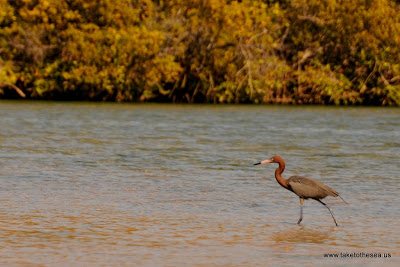 Little Blue Heron (Egretta caerulea)
Little Blue Heron (Egretta caerulea) 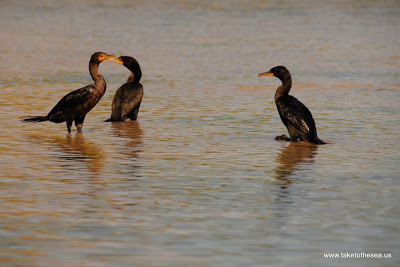 Double Crested Cormorant (Phalacrocorax auritas) – I think?
Double Crested Cormorant (Phalacrocorax auritas) – I think?
After four hours of playing and relaxing in the mangroves we returned to Serenity, pleased (as always) to find that she hadn’t run aground or drifted out to sea. We were also pleased to see that the wind was blowing from the SW, which would be perfect for our 7 mile trip to San Evaristo.
We raised the sails in around 10 knots of wind and just as we got the sails trimmed, the wind began to die down, meaning we were only making about 2 knots. We turned on the motor for the end of the journey to San Evaristo and arrived at sunset. All in all an awesome day of travel. Totally worth the resultant sunburn.
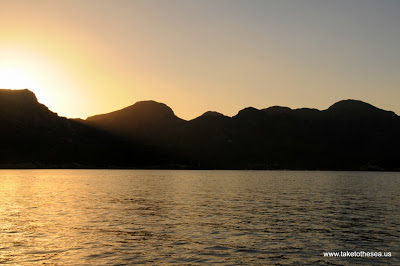 Sunset over the Sierra de la Giganta range and San Evaristo.
Sunset over the Sierra de la Giganta range and San Evaristo. 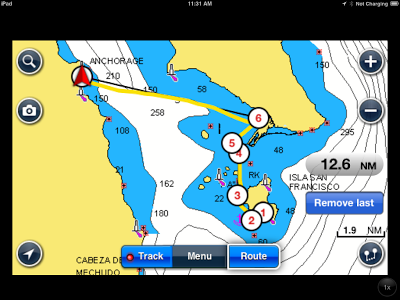 Our route on our Navionics chart.
Our route on our Navionics chart.